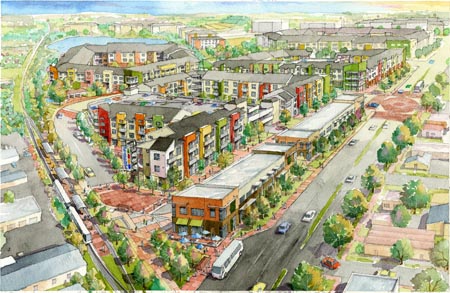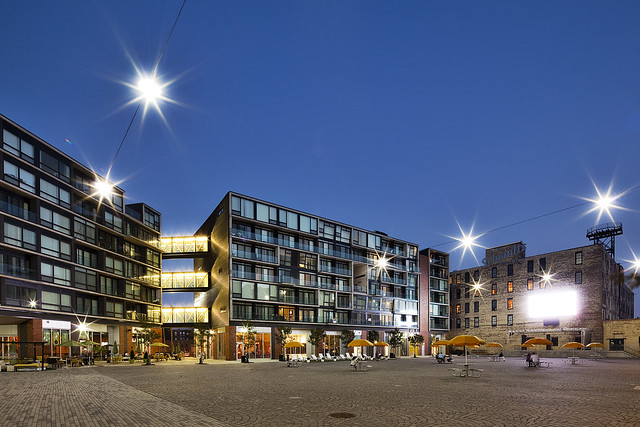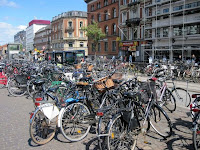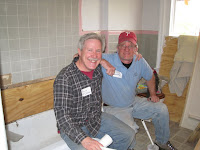At the end of classes, we had a 4-day study tour planned to visit 3 cities in Norway; Oslo, Voss, and Bergen. Joining us on the trip would not be our professor, but instead the program assistant, Emilio, as well as
Saturday night we took an overnight cruise to
Oslo, Norway. It was my first time on a cruise, it was amazing how incredibly large the ship was, hundreds of rooms, a half a dozen places to eat, a spa, movie theater, duty-free shops, and even a discotheque. After an evening of drinks I ended up at the disco with a few new friends, out of character but it was a blast. The weather was wet and cold, but waking up early to watch the ship maneuver through
the straight was impressive.
Arriving in Oslo, the first thing we noticed was the striking white marble and granite
Opera House. A quick summary via About.com:
 Approaching the Oslo Opera house on an overcast day, you may imagine that the building is an enormous glacier sliding into the fjord. White granite combines with Italian marble to create the illusion of glistening ice. The sloping roof angles down to the water like a jagged chunk of ice. Completed in 2007, the Oslo Opera House (Operahuset in Norwegian) reflects the landscape of Norway and also the aesthetics of its people. The government wanted the new Opera House to become a cultural landmark for Norway.
Approaching the Oslo Opera house on an overcast day, you may imagine that the building is an enormous glacier sliding into the fjord. White granite combines with Italian marble to create the illusion of glistening ice. The sloping roof angles down to the water like a jagged chunk of ice. Completed in 2007, the Oslo Opera House (Operahuset in Norwegian) reflects the landscape of Norway and also the aesthetics of its people. The government wanted the new Opera House to become a cultural landmark for Norway.
After getting to our hotel, we walked as a group to the
Nobel Peace Center for a guided tour of the main exhibit:
Strengths and Convictions. The exhibit was about South Africa's struggle for democracy and dealing with apartheid. The lives of the four remarkable men Albert Luthuli, Desmond Tutu, FW de Klerk and Nelson Mandela, converge and divide as South Africa’s history unfolds. Their stories are told through photos, films and art never previously shown in Norway. It is constructed around a timeline depicting 100 years of South African history, with visual art used as a matrix for the life and times of the four laureates. Upstairs was the annual exhibit, this year for President Obama's Nobel Prize entitled
A Call to Action. The connections between Alfred Nobel’s will and Obama’s work for peace are emphasized in this space.
Next we went to the
Edward Munch Museum. I enjoyed this more than I had anticipated, both because of the artwork and the knowledge of our guide. She had worked over 18 years at the museum and knew the history of all of the paintings. My favorite pieces were the drawings from his childhood, when he was coping with the death of his sister and mother, they are gruesome and beautiful at the same time. Security was extremely high, it was like being at a penitentiary because the Scream had been stolen a few times in the past. For more info on Edward Munch, visit
Artsy’s Edvard Munch page.
Not to be content with just these two galleries, a half-dozen of us headed over to the famous
Viking Ship Museum. I think this was one of my favorite places of the whole study abroad. The museum displays the Viking Age Oseberg ship, the Gokstad ship and Tune ship along with a horse cart, wood carvings, and sleds, all of which are meticulously detailed. Just a 5-minute walk away from the Viking Ship Museum was
Gol Stave Church. I hadn't planned on seeing this, but it was one of those tourist days where I took photos of everything I could see. The church was beautiful in it's own way, dark and powerful, it made me feel as if I was transported back into medieval dark ages.
Oslo was a small city, we were able to walk across most of it in about 15 minutes. It was cleaner than Philadelphia, but we instantly noticed it was less-maintained than Copenhagen. There also seemed to be more rough-looking people in the city square, people without an agenda or clean clothes. It's hard to get a good perception of a beautiful city in less than a day, but that's what happens on trips like this. Soon enough it was time to go, we packed our bags and took a 6-hour train ride to Voss, home of some of the Norwegian fjords and at the time, an extreme sports festival.
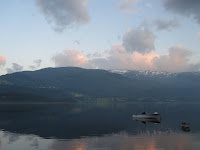
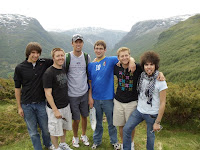
We arrived in
Voss at around 11pm, and as if the late sun wasn't strange enough in Oslo and Copenhagen, it was even more strange
here. Here is a photo that was taken behind our hotel, at around 11:30 at night - it didn't get much darker than this at all. The evening was spend just sitting on a patio by the lake, enjoying a few stories and drinks. Early the next day, we all gathered for our hiking trip through the Fjords - which are formed when a glacier cuts a valley by abrasion of the surrounding mountains, leaving behind awe-inspiring sights. We spent the day doing some pretty easy hiking through the mountains about 30 minutes outside of Voss. Look me up on
Facebook for a lot of photos taken during this trip. Our tour guide told us a story about how trolls are a part of Nordic culture. The summer homes in the mountains were occupied by the women and children in the summertime, and when they would travel up in the spring, they would bang pots and pans to scare away the trolls. They blamed rock slides, fires, and other things on these trolls - anything unexplained that is now known with a bit of science and geology education. It was a great hike, one of my fondest memories of the trip.

Lastly, we took another train ride, this time it was a 2-hour trip to
Bergen, which is located on the
western shore of NorwayVoss, we spent the last two days of the trip here. The city was built as a trading post to northern Scandinavia, most of the business was cod fishing. Similar to Oslo, their diets were heavy in fish and vegetables. They have a very popular and tourist-laden fish market in the heart of downtown. I picked up some souvenirs like moose sausage and knitted hats, and also some fish soup (cheap and delicious). Then we spent time with the Bergen city government and listened to their plans to turn Bergen into a carbon-neutral city by 2050. With the introduction of a larger light-speed rail system and more public buses, they hope to consolidate growth and make public transit the more viable option to cars.
While it was ambitious, I didn't come away impressed, and perhaps that's because we had just spent two weeks in forward-thinking Copenhagen. Also, it made me respect the
Philadelphia Greenworks plan set forth by Mayor Nutter. For the first time I missed and respected what we're doing in Philadelphia. No city is perfect, but great things are happening here. I guess it was the perfect last meeting we had on this trip as I started daydreaming half-way through about things I want to do here - building my network, affordable housing, community enhancements… With all of this in mind, I had plenty to think about for my trip home.
I probably missed many details - so next time you see me, strike up a conversation. Next I'll post less about me and more about some things that I've re-thought since this experience.





